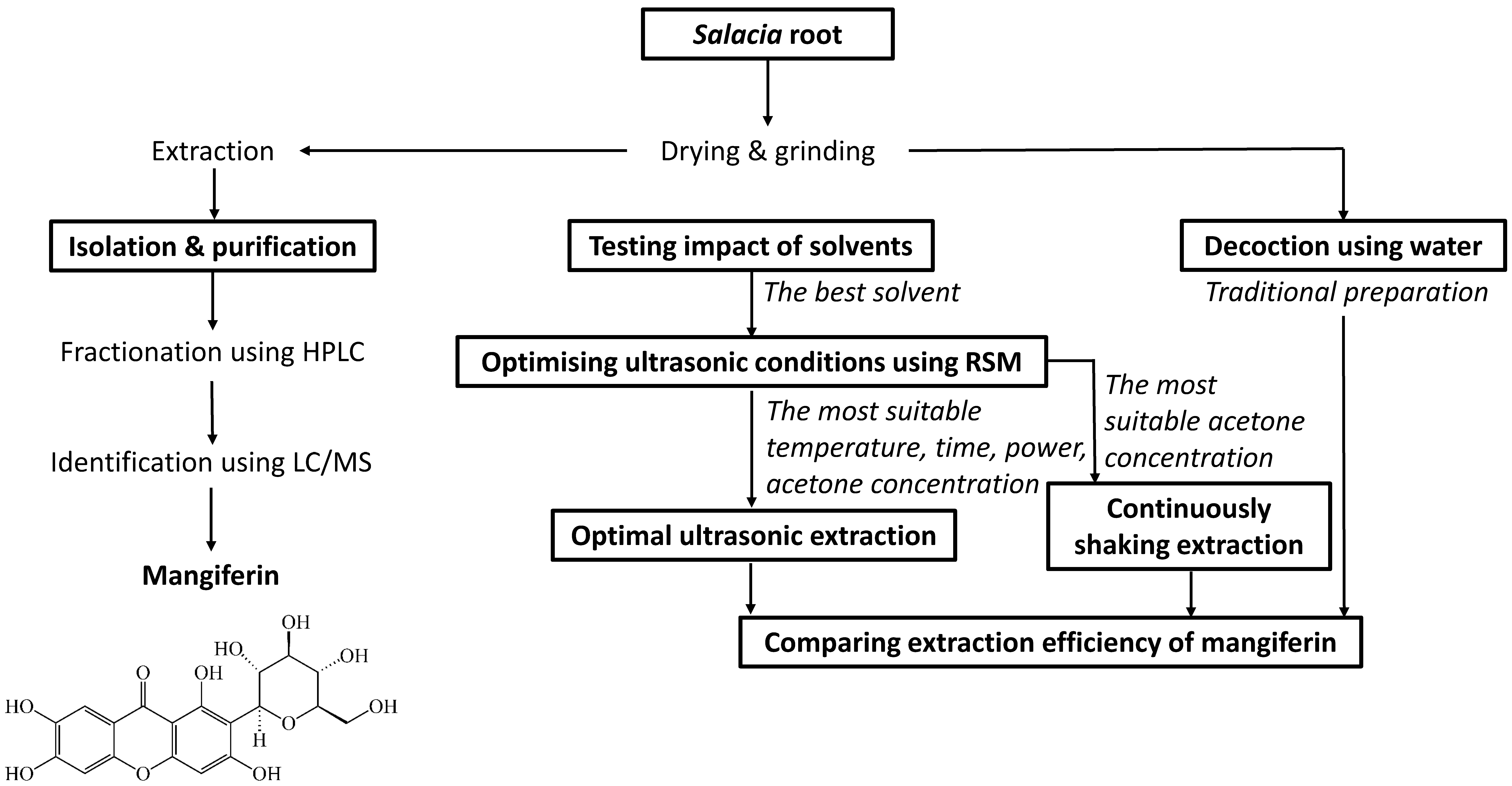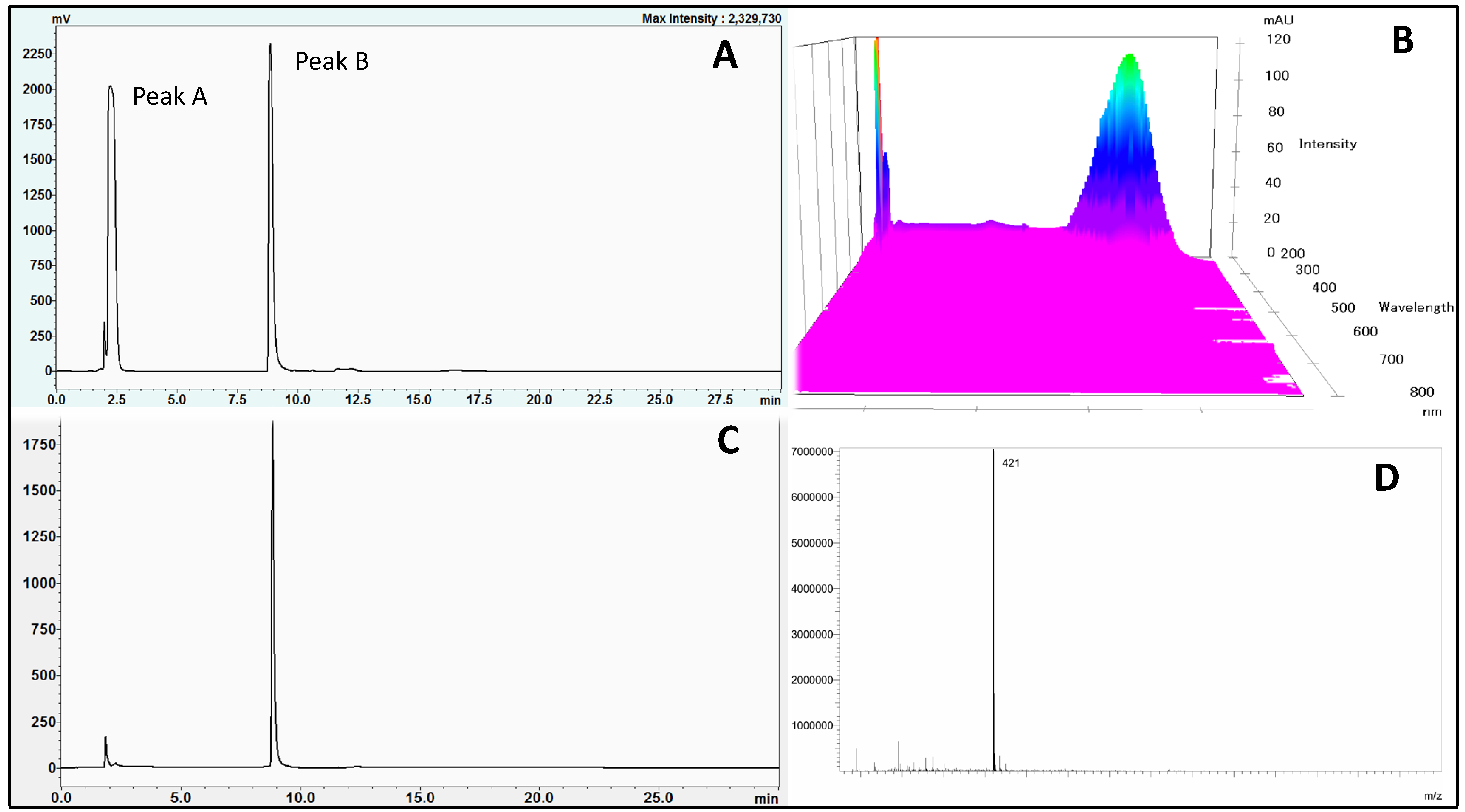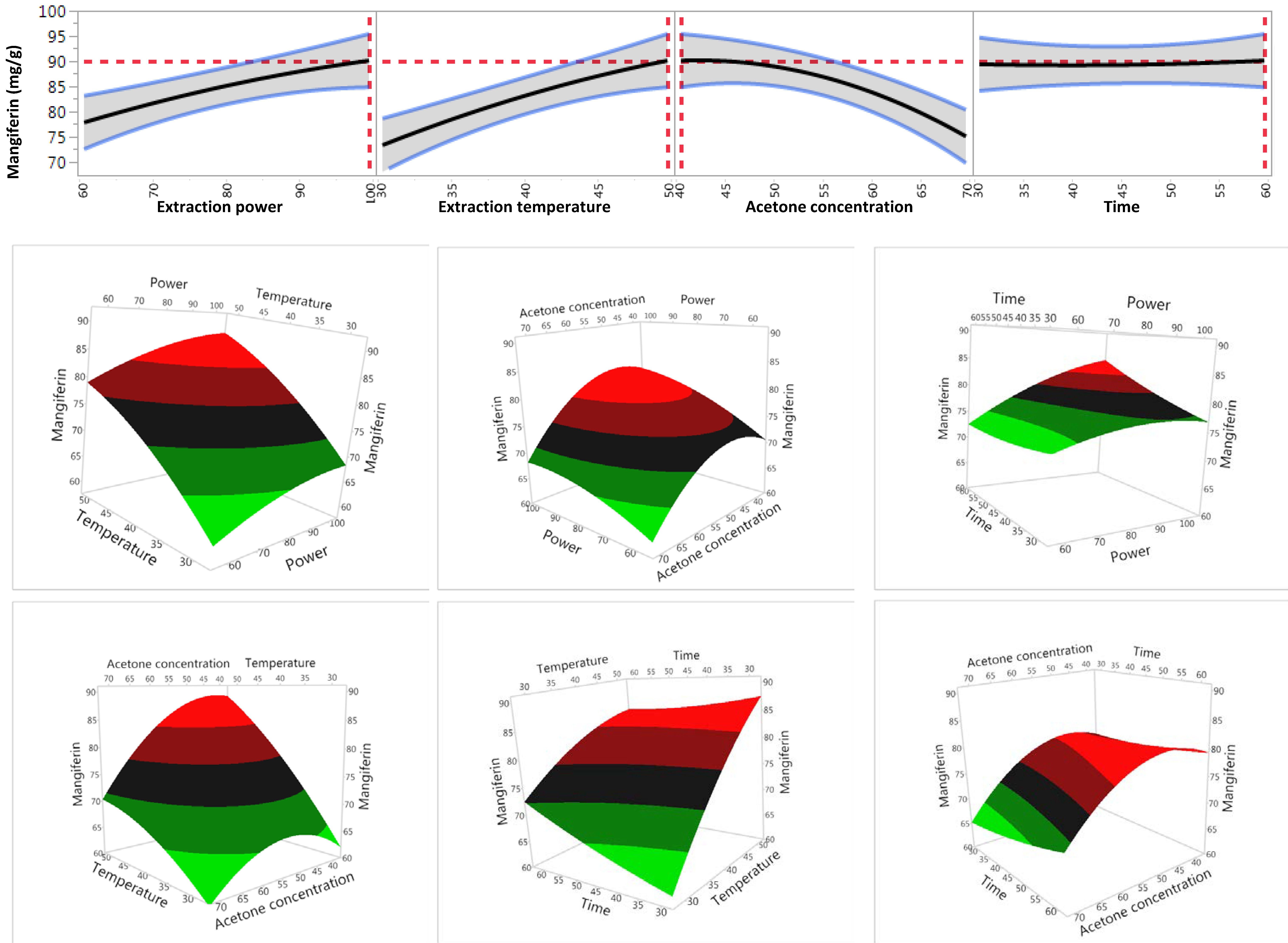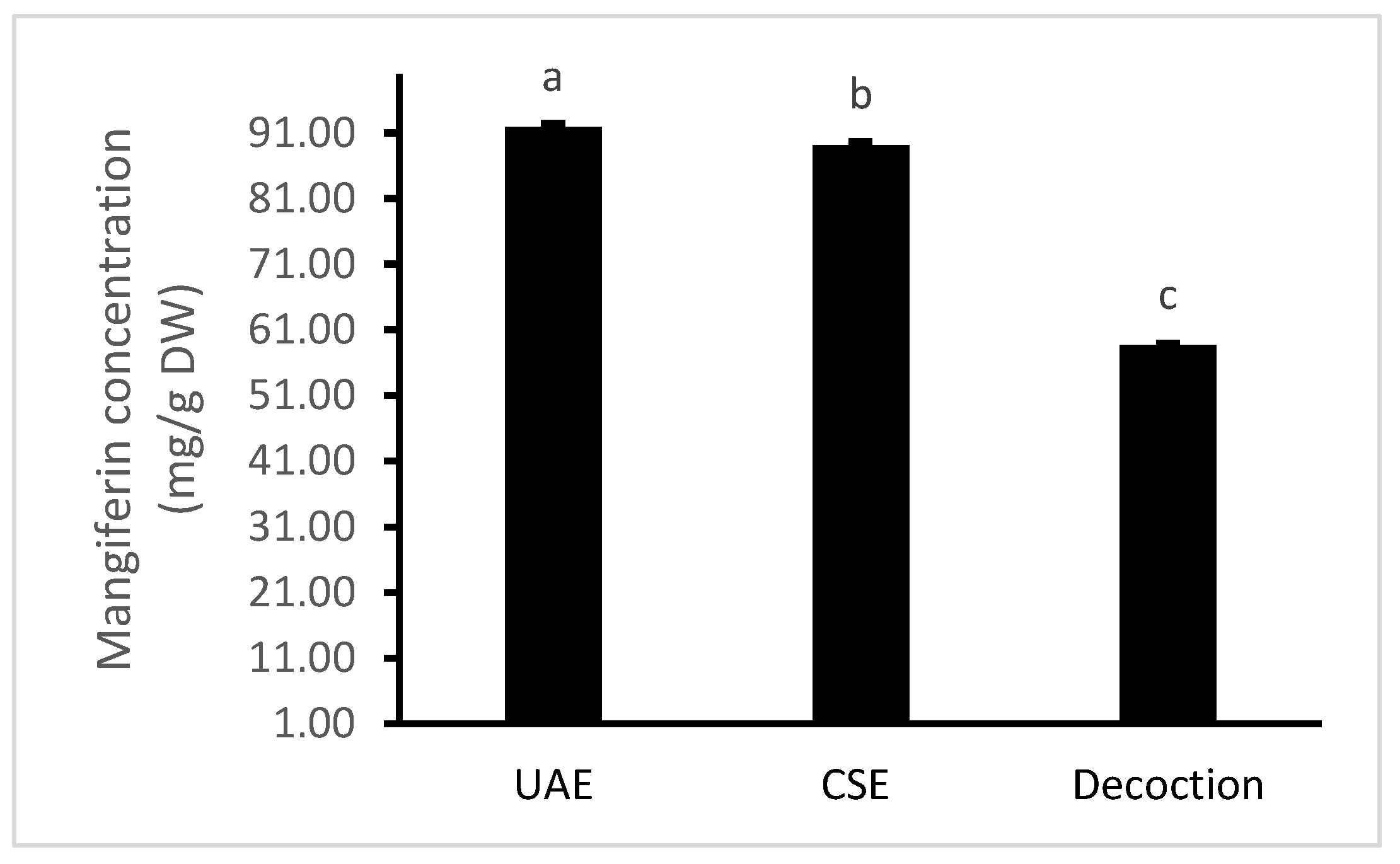Isolation and Maximisation of Extraction of Mangiferin from the Root of Salacia chinensis L.
Abstract
1. Introduction
2. Materials and Methods
2.1. Materials
2.2. Methods
2.2.1. Experimental Design
2.2.2. Isolation and Identification of Mangiferin in S. chinensis Root Extract
2.2.3. Impact of Different Solvents on Recovery of Mangiferin
2.2.4. Optimisation of UAE Conditions for Recovery of Mangiferin
β34X3 X4 + β11X12 + β22X22 + β33X32 + β44X42
2.2.5. Continuously Shaking Extraction
2.2.6. Decoction
2.3. Statistical Analysis
3. Results
3.1. Identification of Mangiferin in S. chinensis Root Extract
3.2. Impact of Type of Solvent on the Yield of Mangiferin
3.3. Optimisation of UAE Conditions for Recovery of Mangiferin
0.0055X1X4 − 0.0152X2X4 + 0.0027X3X4 − 0.0029X12 − 0.0141X22 − 0.0190X32 + 0.0022X42
3.4. Comparison of UAE with CSE and Decoction Extraction Methods
4. Conclusions
Author Contributions
Funding
Acknowledgments
Conflicts of Interest
References
- Gold-Smith, F.; Fernandez, A.; Bishop, K. Mangiferin and cancer: Mechanisms of action. Nutrients 2016, 8, 396. [Google Scholar] [CrossRef]
- Saha, S.; Sadhukhan, P.; Sil, P.C. Mangiferin: A xanthonoid with multipotent anti-inflammatory potential. Biofactors 2016, 42, 459–474. [Google Scholar] [CrossRef]
- Asif, A.; Farooq, U.; Akram, K.; Hayat, Z.; Shafi, A.; Sarfraz, F.; Sidhu, M.A.I.; Rehman, H.; Aftab, S. Therapeutic potentials of bioactive compounds from mango fruit wastes. Trend Food Sci. Technol. 2016, 53, 102–112. [Google Scholar] [CrossRef]
- Imran, M.; Arshad, M.S.; Butt, M.S.; Kwon, J.-H.; Arshad, M.U.; Sultan, M.T. Mangiferin: A natural miracle bioactive compound against lifestyle related disorders. Lipids Health Dis. 2017, 16, 1–17. [Google Scholar] [CrossRef]
- Chavan, J.J.; Ghadage, D.M.; Bhoite, A.S.; Umdale, S.D. Micropropagation, molecular profiling and RP-HPLC determination of mangiferin across various regeneration stages of Saptarangi (Salacia chinensis L.). Ind. Crops Prod. 2015, 76, 1123–1132. [Google Scholar] [CrossRef]
- Ngo, T.V.; Scarlett, C.J.; Bowyer, M.C.; Vuong, Q.V. Phytochemical and Antioxidant Properties from Different Parts of Salacia chinensis L. J. Biol. Act. Prod. Nat. 2017, 7, 401–410. [Google Scholar] [CrossRef]
- Chavan, J.J.; Ghadage, D.M.; Kshirsagar, P.R.; Kudale, S.S. Optimization of extraction techniques and RP-HPLC analysis of antidiabetic and anticancer drug Mangiferin from roots of ‘Saptarangi’ (Salacia chinensis L.). J. Liq. Chromatogr. Relat. Technol. 2015, 38, 963–969. [Google Scholar] [CrossRef]
- Tiwari, P.; Kumar, B.; Kaur, M.; Kaur, G.; Kaur, H. Phytochemical screening and extraction: A review. Int. Pharm. Sci. 2011, 1, 98–106. [Google Scholar]
- Azmir, J.; Zaidul, I.S.M.; Rahman, M.M.; Sharif, K.M.; Mohamed, A.; Sahena, F.; Jahurul, M.H.A.; Ghafoor, K.; Norulaini, N.A.N.; Omar, A.K.M. Techniques for extraction of bioactive compounds from plant materials: A review. J. Food Eng. 2013, 117, 426–436. [Google Scholar] [CrossRef]
- Do, Q.D.; Angkawijaya, A.E.; Tran, N.P.L.; Huynh, L.H.; Soetaredjo, F.E.; Ismadji, S.; Ju, Y.H. Effect of extraction solvent on total phenol content, total flavonoid content, and antioxidant activity of Limnophila aromatica. J. Food Drug Anal. 2014, 22, 296–302. [Google Scholar] [CrossRef]
- Ncube, A.J.; Okoh, A.I. Assessment techniques of antimicrobial properties of natural compounds of plant origin: Current methods and future trends. Afr. J. Biotechnol. 2008, 7, 1797–1806. [Google Scholar] [CrossRef]
- Handa, S.S. An overview of extraction techniques for medicinal and aromatic plants. In Extraction Technoloties for Medicinal and Aromatic Plants; Handa, S.S., Khanuja, S.P.S., Longo, G., Rakesh, D.D., Eds.; International Centre for Science and High Technology: Trieste, Italy, 2008; pp. 21–54. [Google Scholar]
- Nayak, B.; Dahmoune, F.; Moussi, K.; Remini, H.; Dairi, S.; Aoun, O.; Khodir, M. Comparison of microware, ultrasound and accelerated—Assisted solvent extraction for recovery of polyphenols from Citrus sinensis peels. Food Chem. 2015, 187, 507–516. [Google Scholar] [CrossRef]
- Libran, C.M.; Mayor, L.; Garcia-Castello, E.M.; Vidal-Brotons, D. Polyphenol extraction from grape wastes: Solvent and pH effect. Agric. Sci. 2013, 4, 56–62. [Google Scholar]
- Mokrani, A.; Madani, K. Effect of solvent, time and temperature on the extraction of phenolic compounds and antioxidant capacity of peach (Prunus persica L.) fruit. Sep. Purif. Technol. 2016, 162, 68–76. [Google Scholar] [CrossRef]
- Kchaou, W.; Abbès, F.; Blecker, C.; Attia, H.; Besbes, S. Effects of extraction solvents on phenolic contents and antioxidant activities of Tunisian date varieties (Phoenix dactylifera L.). Ind. Crops Prod. 2013, 45, 262–269. [Google Scholar] [CrossRef]
- Karunanayake, E.H.; Sirimanne, S.R. Mangiferin from the root bark of Salacia reticulata. J. Ethnopharmacol. 1985, 13, 227–228. [Google Scholar] [CrossRef]
- Srinivasan, G.V.; Ravi, S.; Tushar, K.V.; Balachandran, I. Quantitative Determination of Mangiferin from the Roots of Salacia fruticosa and the Antioxidant Studies. J. Trop. Med. Plants 2009, 10, 213–218. [Google Scholar]
- Muraoka, O.; Morikawa, T.; Miyake, S.; Akaki, J.; Ninomiya, K.; Yoshikawa, M. Quantitative determination of potent α-glucosidase inhibitors, salacinol and kotalanol, in Salacia species using liquid chromatography-mass spectrometry. J. Pharm. Biomed. Anal. 2010, 52, 770–773. [Google Scholar] [CrossRef]
- Chavan, J.J.; Jagtap, U.B.; Gaikwad, N.B.; Dixit, G.B.; Bapat, V.A. Total phenolics, flavonoids and antioxidant activity of Saptarangi (Salacia chinensis L.) fruit pulp. J. Plant Biochem. Biotechnol. 2012, 22, 409–413. [Google Scholar] [CrossRef]
- Sellamuthu, P.S.; Arulselvan, P.; Fakurazi, S. Beneficial effects of mangiferin isolated from Salacia chinensis on biochemical and hematological parameters in rats with streptozotocin-induced diabetes. Pak. J. Pharm. Sci. 2014, 27, 161–167. [Google Scholar]
- Dailey, A.; Vuong, V.Q. Effect of extraction solvents on recovery of bioactive compounds and antioxidant properties from macadamia (Macadamia tetraphylla) skin waste. Cogent Food Agric. 2015, 1, 1–10. [Google Scholar] [CrossRef]
- Ngo, T.V.; Scarlett, C.J.; Bowyer, M.C.; Ngo, P.D.; Vuong, Q.V. Impact of Different Extraction Solvents on Bioactive Compounds and Antioxidant Capacity from the Root of Salacia chinensis L. J. Food Qual. 2017, 2017, 1–8. [Google Scholar] [CrossRef]
- Ngo, T.V.; Bowyer, M.C.; Scarlett, C.J.; Vuong, Q.V. Ultrasonic assisted extraction as an advanced technique for the extraction of bioactive compounds from Salacia chinensis root: A comparison with decoction and continuously shaking extraction. J. Plant Biochem. Biotechnol. 2019. under review. [Google Scholar]




| Run | Ultrasonic Conditions | Experimental Values (mg/g DW, n = 3) | |||
|---|---|---|---|---|---|
| Power | Temp | Acetone Conc. | Time | ||
| 1 | 60 | 30 | 55 | 45 | 65.55 ± 3.25 |
| 2 | 80 | 30 | 55 | 30 | 65.60 ± 2.44 |
| 3 | 80 | 30 | 70 | 45 | 64.34 ± 0.44 |
| 4 | 80 | 30 | 40 | 45 | 68.04 ± 2.71 |
| 5 | 80 | 30 | 55 | 60 | 71.27 ± 0.64 |
| 6 | 100 | 30 | 55 | 45 | 71.08 ± 0.43 |
| 7 | 60 | 40 | 55 | 30 | 73.37 ± 1.53 |
| 8 | 60 | 40 | 70 | 45 | 67.54 ± 0.74 |
| 9 | 60 | 40 | 40 | 45 | 72.10 ± 2.02 |
| 10 | 60 | 40 | 55 | 60 | 75.23 ± 2.19 |
| 11 | 80 | 40 | 40 | 30 | 78.63 ± 0.33 |
| 12 | 80 | 40 | 70 | 30 | 66.32 ± 3.55 |
| 13 | 80 | 40 | 55 | 45 | 78.20 ± 0.16 |
| 14 | 80 | 40 | 70 | 60 | 70.79 ± 0.65 |
| 15 | 80 | 40 | 40 | 60 | 80.70 ± 0.25 |
| 16 | 100 | 40 | 55 | 30 | 76.81 ± 3.31 |
| 17 | 100 | 40 | 40 | 45 | 80.15 ± 1.91 |
| 18 | 10 | 40 | 70 | 45 | 72.07 ± 4.38 |
| 19 | 100 | 40 | 55 | 60 | 85.25 ± 1.63 |
| 20 | 60 | 50 | 55 | 45 | 78.83 ± 1.92 |
| 21 | 80 | 50 | 55 | 30 | 88.25 ± 0.21 |
| 22 | 80 | 50 | 40 | 45 | 86.48 ± 0.87 |
| 23 | 80 | 50 | 70 | 45 | 71.64 ± 1.50 |
| 24 | 80 | 50 | 55 | 60 | 84.78 ± 3.32 |
| 25 | 100 | 50 | 55 | 45 | 85.90 ± 0.60 |
| Solvent | Concentration of Mangiferin (mg/g DW) |
|---|---|
| H2O | 20.45 ± 0.85 f |
| Ethanol | 45.43 ± 0.23 e |
| Ethanol 50% | 72.45 ± 0.48 b |
| Methanol | 57.96 ± 2.33 d |
| Methanol 50% | 66.10 ± 1.49 c |
| Acetone | 10.36 ± 0.50 g |
| Acetone 50% | 78.76 ± 0.78 a |
| Parameter | Standard Error | DF | Sum of Squares | F Value | Prob > F |
|---|---|---|---|---|---|
| β0 | 1.53 | <0.0001 * | |||
| β1 | 0.44 | 1 | 373.52 | 53.27 | <0.0001 * |
| β2 | 0.44 | 1 | 2024.85 | 288.75 | <0.0001 * |
| β3 | 0.44 | 1 | 713.25 | 101.71 | <0.0001 * |
| β4 | 0.44 | 1 | 90.60 | 12.92 | 0.0007 * |
| β12 | 0.76 | 1 | 1.79 | 0.26 | 0.6148 |
| β13 | 0.76 | 1 | 9.31 | 1.33 | 0.2538 |
| β23 | 0.76 | 1 | 92.91 | 13.25 | 0.0006 * |
| β14 | 0.76 | 1 | 32.57 | 4.64 | 0.0352 * |
| β24 | 0.76 | 1 | 62.56 | 8.92 | 0.0041 * |
| β34 | 0.76 | 1 | 4.30 | 0.61 | 0.4369 |
| β11 | 0.91 | 1 | 11.12 | 1.59 | 0.2127 |
| β22 | 0.91 | 1 | 16.87 | 2.41 | 0.1261 |
| β33 | 0.91 | 1 | 155.24 | 22.14 | <0.0001 * |
| β44 | 0.91 | 1 | 2.06 | 0.29 | 0.5895 |
| Lack of fit | 0.0996 | PRESS | 648.44 | ||
| R2 | 0.898 | RMSE | 2.648 | ||
| Adjusted R2 | 0.874 | F ratio of model | 37.87 | ||
| Prob > F | <0.0001 * |
© 2019 by the authors. Licensee MDPI, Basel, Switzerland. This article is an open access article distributed under the terms and conditions of the Creative Commons Attribution (CC BY) license (http://creativecommons.org/licenses/by/4.0/).
Share and Cite
Ngo, T.V.; Scarlett, C.J.; Bowyer, M.C.; Vuong, Q.V. Isolation and Maximisation of Extraction of Mangiferin from the Root of Salacia chinensis L. Separations 2019, 6, 44. https://doi.org/10.3390/separations6030044
Ngo TV, Scarlett CJ, Bowyer MC, Vuong QV. Isolation and Maximisation of Extraction of Mangiferin from the Root of Salacia chinensis L. Separations. 2019; 6(3):44. https://doi.org/10.3390/separations6030044
Chicago/Turabian StyleNgo, Thanh V., Christopher J. Scarlett, Michael C. Bowyer, and Quan V. Vuong. 2019. "Isolation and Maximisation of Extraction of Mangiferin from the Root of Salacia chinensis L." Separations 6, no. 3: 44. https://doi.org/10.3390/separations6030044
APA StyleNgo, T. V., Scarlett, C. J., Bowyer, M. C., & Vuong, Q. V. (2019). Isolation and Maximisation of Extraction of Mangiferin from the Root of Salacia chinensis L. Separations, 6(3), 44. https://doi.org/10.3390/separations6030044






